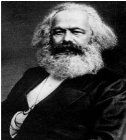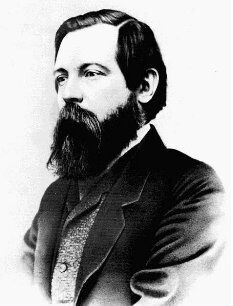The concepts covered in this concept sheet go beyond what is covered in secondary school. This is supplemental information for students who want to find out more.
There are several important concepts related to the notions of social classes and class struggle. Many of these concepts influenced the political, economic and philosophical doctrines that developed after the Industrial Revolution.
Karl Marx developed and influenced many of these concepts and doctrines. His father was a lawyer and he studied philosophy, law and history. Marx expressed radical perspectives and ideas very early on, leading to exile several times throughout his life.
Very early, Marx embraced communism and developed his conception of the world around social classes. In 1844, Karl Marx met Friedrich Engels, with whom he worked throughout his life. They viewed communism as the solution to class struggles and the difficulties experienced by workers.
Friedrich Engels was born into a bourgeois family and studied political economy. His father was a factory owner, so Friedrich Engels was aware of the workers’ difficult conditions. Engels worked for the family business for a long time, which allowed him to earn a more stable income. Besides working in the factory, Engels worked with newspapers and studied political economy. He believed that the best way to understand politics and history was by linking them with economic and social development.
Social problems would therefore be caused by the impacts of the institution of private property. These issues could be eradicated by class struggle. Even before he met Karl Marx, Engels shared several of the same ideas. This is why, after they first met, they continued to work together until Marx’s death in 1883.
Throughout their collaboration, Marx and Engels tried to explain the principles of scientific communism and also organized an international movement among the working class. This movement aimed to achieve the principles of scientific communism. Marx and Engels wrote several works, including The Manifesto of the Communist Party (The Communist Manifesto). This manifesto would become the program of the Communist League, founded in 1847. One of the most famous phrases from this manifesto is “Workers of the world, unite!”
In this text, Marx and Engels established the ideas that would influence all future texts and organizations. They explained the power that the economic system held over modern society. This power created social classes. The manifesto promoted the overthrow of the capitalist class through the workers’ revolution. Marx and Engels wanted to establish a classless society in which capital (money) would belong to everyone.
Before industrialization, society could be divided into different hierarchical groups. These groups were well defined, like the three orders in French society before the French Revolution. When industrialization occurred, a new definition was needed since there was no longer a legal definition of the different social groups. However, homogeneous social groups still existed within society.
Each group could be characterized by social status, way of life, material conditions, behaviours, interests, actions, worldview, etc. The concept of social classes was created to define this new reality. However, these social classes were not static, and people could change social classes over their lifetime. The three principal social classes in industrialized societies were the working class (proletariat), the middle class and the bourgeoisie.
Marx defined social classes according to their role in the production process. According to his theory, the bourgeoisie was the dominant class that controlled and owned the means of production. The proletariat were the oppressed class, exploited by the ruling class. This class did not own the means of production and therefore had to offer their own labour to the bourgeoisie. Marx’s definition focused more on the conflict between social classes.
However, according to Marx, for a group to truly be a social class, it must be aware of this oppositional relationship. He called this class consciousness. This consciousness pushes the oppressed class to rise up and organize itself into parties or unions. It is also class consciousness that drives the struggle between the classes.
At the end of the Middle Ages, the bourgeoisie was the class between the nobles and the peasants. The bourgeois mainly worked in commerce, finance and handicrafts. At the end of the French Revolution, the bourgeois were free men with rights, including access to private property. These new rights made the bourgeoisie the ruling class, a position that grew with industrial development.
In Karl Marx’s theory, the bourgeoisie of capitalist countries own all the means of production, such as money, material, machines, means of investment and profits. The bourgeoisie was therefore in a position to exploit the proletariat. The bourgeoisie’s main goal was to keep the cost of labour as low as possible. According to Marx’s theory, the bourgeoisie not only ruled the working class, but it also ruled society because its members were educated individuals with political and economic influence.
The bourgeoisie was separated into three categories:
-
The haute bourgeoisie (upper class) was made up of the wealthiest individuals who controlled all means of production
-
The middle bourgeoisie (middle class)was made up of senior executives and liberal professionals with high incomes
-
The petite bourgeoisie (lower middle class) was made up of middle and lower management, small business owners and small agricultural landowners
The middle and petite bourgeoisie formed the middle class.
According to Marx, the working class was the lowest class of citizens, with only their own labour to sell. They sold their labour to the owners of the means of production. The working class included both employed and unemployed people. Its goal was to make the highest wage possible. This was the complete opposite of the bourgeoisie’s goal, which created tension between the classes and ultimately fuelled the class struggle.
One of Marx’s theories is the struggle between classes. This struggle is expressed by a strong opposition between the classes. This conflict can sometimes be expressed through violence. The struggle is caused by the opposing interests of each class: they both want to gain power. Therefore, the class in power aims to prevent the other classes from taking power.
The issues at stake in the class struggle are power, wealth distribution, property and authority. The struggle opposes the working class and the bourgeoisie. However, class struggle can be considered a reflection of human history. Marx asserted that there has always been class struggle in history, whether in slave, feudal or capitalist societies. According to Marx, the class struggle is the key to achieving the ultimate goal of a communist classless society.
According to Marx, the oppressed class can only progress through struggle. For there to be a struggle, classes must be organized (political groups, trade unions or associations) and the social connections between the members of a class must be very strong (strong collective solidarity). Only a united and organized class can truly equip itself with the means to act collectively. Marx never witnessed the outcome of a class struggle as he had described it in his theories.
This expression, mainly used by Marx, designates the first stage of society’s shift towards communism, replacing capitalism (which is the dictatorship of the bourgeoisie). The goal of the dictatorship of the proletariat is to overthrow the ruling class that holds all the economic and political power. To achieve this, the working class must seize all power. Marx believed that the proletariat had the ability to transform society, since the economy essentially relied on this social class.
When workers take power, they must establish a state that takes all the measures needed to transfer the means of production from the bourgeoisie to the proletariat. Marx’s theory of the dictatorship of the proletariat is presented as the transitional phase between a capitalist society and a classless society (communism).
According to Engels, the first dictatorship of the proletariat was established during the Paris Commune. Another dictatorship of the proletariat was officially declared in the new Russian constitution of 1918, until 1936.
Today, the collective term for all Marx’s theories is Marxism. It isn’t a political structure but rather a broad theory that presents concepts and ideas for an ideal society. Marxism includes ideas about social classes, class struggle, communism and the dictatorship of the proletariat.
The Industrial Revolution spread rapidly throughout several countries. This industrial boom led to miserable living conditions everywhere. Unregulated economic development gave rise to humanitarian and ethical concerns, which led to the emergence of several new political philosophies, including socialism, anarchism and communism. Before delving into these new philosophies, it’s important to discuss liberalism, which was the prevailing economic ideology throughout the Industrial Revolution.
Liberalism is a legal ideology rather than an economic ideology. The fundamental requirements of liberalism involve respecting unalienable and natural rights such as life, action and property. Individuals are responsible for the consequences of their choices. However, because freedom comes first, behaviours or choices should not be imposed on people, just as people shouldn’t be denied certain behaviours or choices. This ideology comes directly from the French Revolution and was largely inspired by John Locke.
Capitalism is the result of the application of legal liberalism. The economic principles of liberalism require total freedom of enterprise and of the market. Equilibrium is established by the natural order of the law of supply and demand. Economic liberalism is therefore opposed to the state regulating the means of production, except to guarantee a fair market and to coordinate businesses.
Socialism is an economic and political ideology that aims to change the system of private ownership of the means of production to communal ownership.
The values of socialism are:
-
Classless society
-
Equal opportunity
-
Social justice
-
Equal distribution of resources
-
Solidarity
-
Fight against individualism
-
Public interest over individual interest
In a socialist political system, the citizens are the decisionmakers and the state is in charge of coordinating, planning, implementing and managing operations. In Marxist theory, socialism is the transitional period known as the dictatorship of the proletariat. However, for non-Marxists, socialism includes all left-wing parties that want to reorganize society to increase social justice.
Anarchism is a political and philosophical movement that advocates for the abolition of authority, power and hierarchy. Anarchism criticizes all institutions, including capitalism, the army, the police, the patriarchal family, religion and especially the state. This ideology also opposes all forms of differential treatment, including moral, social, political and economic discrimination. Anarchism seeks to establish a society with libertarian values, free from control and in which liberated and equal people cooperate freely.
Communism is a social ideology that advocates the abolition of private ownership of the means of production and commerce. Communism is inspired by socialism and the theories of Marx and Engels. This ideology is an alternative to capitalism. A true communist society is a classless and stateless society in which the means of production is publicly owned.
All attempts to establish a communist regime have failed. One reason for failure may be the fact that this ideology’s principles disregard any notion of individuality. Communism as Marx imagined it remains a theory.

